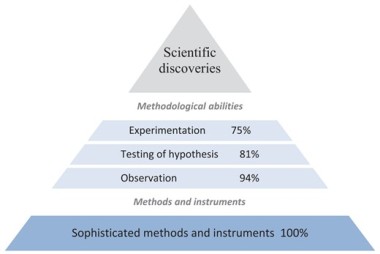Redefining the scientific method: as the use of sophisticated scientific methods that extend our mind ( academic.oup.com )
We can best view the method of science as the use of our sophisticated methodological toolbox
Metadata
- Author: OUP Academic
- Category: article
- URL: https://academic.oup.com/pnasnexus/article/3/4/pgae112/7626940?login=false
Highlights
Scientific, medical, and technological knowledge has transformed our world, but we still poorly understand the nature of scientific methodology.
scientific methodology has not been systematically analyzed using large-scale data and scientific methods themselves as it is viewed as not easily amenable to scientific study.
This study reveals that 25% of all discoveries since 1900 did not apply the common scientific method (all three features)—with 6% of discoveries using no observation, 23% using no experimentation, and 17% not testing a hypothesis.
Empirical evidence thus challenges the common view of the scientific method.
This provides a new perspective to the scientific method—embedded in our sophisticated methods and instruments—and suggests that we need to reform and extend the way we view the scientific method and discovery process.
In fact, hundreds of major scientific discoveries did not use “the scientific method”, as defined in science dictionaries as the combined process of “the collection of data through observation and experiment, and the formulation and testing of hypotheses” (1). In other words, it is “The process of observing, asking questions, and seeking answers through tests and experiments” (2, cf. 3).
In general, this universal method is commonly viewed as a unifying method of science and can be traced back at least to Francis Bacon's theory of scientific methodology in 1620 which popularized the concept
Science thus does not always fit the textbook definition.
Comparison across fields provides evidence that the common scientific method was not applied in making about half of all Nobel Prize discoveries in astronomy, economics and social sciences, and a quarter of such discoveries in physics, as highlighted in Fig. 2b. Some discoveries are thus non-experimental and more theoretical in nature, while others are made in an exploratory way, without explicitly formulating and testing a preestablished hypothesis.
We find that one general feature of scientific methodology is applied in making science's major discoveries: the use of sophisticated methods or instruments. These are defined here as scientific methods and instruments that extend our cognitive and sensory abilities—such as statistical methods, lasers, and chromatography methods. They are external resources (material artifacts) that can be shared and used by others—whereas observing, hypothesizing, and experimenting are, in contrast, largely internal (cognitive) abilities that are not material (Fig. 2).
Just as science has evolved, so should the classic scientific method—which is construed in such general terms that it would be better described as a basic method of reasoning used for human activities (non-scientific and scientific).
An experimental research design was not carried out when Einstein developed the law of the photoelectric effect in 1905 or when Franklin, Crick, and Watson discovered the double helix structure of DNA in 1953 using observational images developed by Franklin.
Direct observation was not made when for example Penrose developed the mathematical proof for black holes in 1965 or when Prigogine developed the theory of dissipative structures in thermodynamics in 1969. A hypothesis was not directly tested when Jerne developed the natural-selection theory of antibody formation in 1955 or when Peebles developed the theoretical framework of physical cosmology in 1965.
Sophisticated methods make research more accurate and reliable and enable us to evaluate the quality of research.
Applying observation and a complex method or instrument, together, is decisive in producing nearly all major discoveries at 94%, illustrating the central importance of empirical sciences in driving discovery and science.
